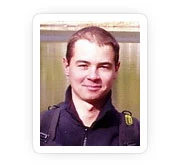Reciprocal Inhibition: The Biomechanical Yin/Yang in Yoga Practice

The concept of the balanced Yin/Yang appears throughout the body. It is present in anatomy where the form of a joint fits its function. Joints that require stability are less mobile and those requiring mobility are less stable. Look at the shape of the hip and shoulder joints to see this concept in action.
Similarly, there are a number of physiological feedback loops that balance the flow of energy in the body. One of these is the primitive spinal cord reflex known as reciprocal inhibition. This reflex causes the antagonist muscle to relax when the synergist contracts.
The Biomechanical Yin/Yang
Muscles fall into two basic groups, depending on what we are doing at any given moment. For example, the quadriceps are the agonists for extending or straightening the knee. The hamstrings stretch when the knee extends and so are the antagonists for this action. The hamstrings become the agonist muscle when the knee bends and the quadriceps become the antagonist. This is a biomechanical Yin/Yang.
Agonists and Antagonists in Janu Sirsasana
Figure 1 below – In the straight leg, the quadriceps (green) are the agonists and the hamstrings (red) are the antagonists.
Figure 2 below – In the flexed leg, the hamstrings (green) are the agonists and the quadriceps (red) are the antagonists.

Reciprocal Inhibition: A Physiological Yin/Yang
It makes sense that there would be a corresponding physiological Yin/Yang to make biomechanical processes such as flexion and extension of the knee energy efficient, i.e., when the agonist muscle contracts, its antagonist relaxes. This process occurs unconsciously through a primitive spinal cord reflex arc that scientists call “reciprocal inhibition.” We can consciously access this reflex arc to deepen and improve our poses.

In Paschimottanasana, the quadriceps muscle is the agonist and the hamstring muscles are the antagonists. Consciously engaging the quadriceps also signals the hamstrings to relax. This takes place via the spinal cord. The nerve impulse that results in contraction of the quadriceps is called excitatory (1) and the impulse to the hamstrings is called inhibitory (2) (see image above). Try this technique to get a bit deeper into this pose and then apply it to different agonist/antagonist muscle groups. Note the added biomechanical benefit of improved alignment in your pose when you use this technique.
Yoga Practice Tips
-
Always build contraction of a muscle gently and slowly. This aids to minimize the risk of injury and soreness.
-
Learn to “regulate” the force of muscle contraction, especially those of large muscles like the quadriceps.
-
Combine reciprocal inhibition with the technique outlined for the muscle spindle to attain greater relaxation of the muscles you are stretching.
-
Allow ample time for recovery between practices.
-
Always practice under the guidance of an experienced teacher.
-
Always, in your particular case, consult your healthcare provider before doing yoga or any exercise program.
If you are new to integrating anatomy into your practice, remember that it is not necessary to memorize this technique on your first pass. Begin by enjoying the beautiful images of the body in yoga. This alone will awaken your brain’s awareness of the anatomy during your practice. Return at a later date for a closer look and then gently go through the motions illustrated above as you practice. Then leave it. Your unconscious mind will create new circuitry while you rest. Enjoy this process, and when you return to the mat you will be surprised at how easily you access this technique.
More on Reciprocal Inhibition from YogaUOnline and Ray Long MD – How Your Downward-Facing Dog Promotes Graceful Aging.
Study with Lillah Schwartz and YogaUOnline – Yoga for a Healthy Back: Addressing Pelvic Asymmetry.
Reprinted with permission from Daily Bandha.
Photos by Daily Bandha.
 Author Ray Long MD FRCSC is a board-certified orthopedic surgeon and the founder of Bandha Yoga. Ray graduated from The University of Michigan Medical School with post-graduate training at Cornell University, McGill University, The University of Montreal and Florida Orthopedic Institute. He has studied hatha yoga for over twenty years, training extensively with B.K.S. Iyengar and other leading yoga masters.
Author Ray Long MD FRCSC is a board-certified orthopedic surgeon and the founder of Bandha Yoga. Ray graduated from The University of Michigan Medical School with post-graduate training at Cornell University, McGill University, The University of Montreal and Florida Orthopedic Institute. He has studied hatha yoga for over twenty years, training extensively with B.K.S. Iyengar and other leading yoga masters.
 3d Graphic Designer / Illustrator Chris Macivor has been involved in the field of digital content creation for well over ten years. He is a graduate of Etobicoke School of the Arts, Sheridan College and Seneca College. Chris considers himself to be equally artistic and technical in nature. As such his work has spanned many genres from film and television to video games and underwater imagery.
3d Graphic Designer / Illustrator Chris Macivor has been involved in the field of digital content creation for well over ten years. He is a graduate of Etobicoke School of the Arts, Sheridan College and Seneca College. Chris considers himself to be equally artistic and technical in nature. As such his work has spanned many genres from film and television to video games and underwater imagery.




